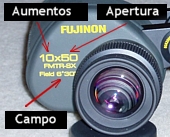![]() Binoculars are small refracting telescopes, which have a built-in prism system to shorten the support tube and avoid inverted vision. They have less magnification capacity than a telescope, but they have a greater field of view. To prevent vibrations, it is advisable to fix them to a photographic tripod. They are classified by the degree of magnification and the aperture diameter, in millimeters, of the front lens. a binocular 7×50, For example, increases 7 times the image and has 50 millimeters opening. For the beginning fan, they are a very important piece of their team.
Binoculars are small refracting telescopes, which have a built-in prism system to shorten the support tube and avoid inverted vision. They have less magnification capacity than a telescope, but they have a greater field of view. To prevent vibrations, it is advisable to fix them to a photographic tripod. They are classified by the degree of magnification and the aperture diameter, in millimeters, of the front lens. a binocular 7×50, For example, increases 7 times the image and has 50 millimeters opening. For the beginning fan, they are a very important piece of their team.
This instrument is characterized by its ease of viewing objects, its wide field of vision and the sensation of depth, when using both eyes. It is the ideal method to learn about the characteristic objects of each constellation, to learn about and recognize the night sky. Its price is much lower than a telescope and it takes less paperwork to start using it. You can lie down on the ground and start to "scan" the sky systematically, or, if you have been using it for a while and plan to do more complex things, observing variable stars and searching for comets are two good objectives.
Increases and openings

The binoculars have numbers engraved on them similar to “7 x 35”, “10 x 50”, “7 x 50”, etc. The first number (7, 10) refers to the increase that binoculars provide, the second is the opening expressed in millimeters. A “7x50” binocular will have 7x magnification and a 50mm objective; 7x is probably the most common magnification, but it is possible to purchase binoculars with 10x, 15x, or even 20x magnification. The 10x50 model is one of the most commonly used by amateurs (objects up to magnitude 10 can be seen!). It is recommended that the objective aperture be no smaller than 35mm, but for objectives larger than 100mm it is necessary to mount the binoculars on a tripod or stand due to their weight.


